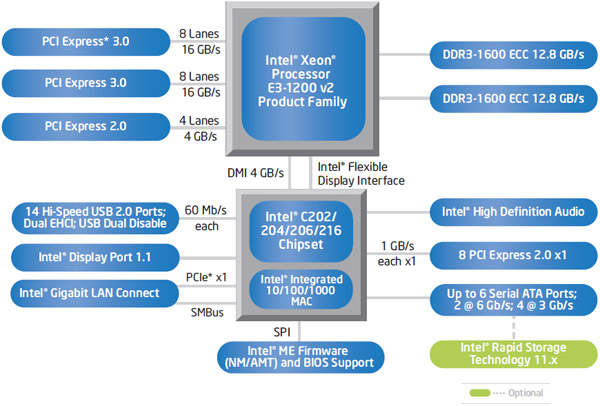Intel Xeon E3-1280 v2 Review: Ivy Bridge Goes Professional
Intel recently introduced its Xeon E3-1200 v2 CPUs, based on the Ivy Bridge architecture. Though they're very similar to the third-generation desktop Core chips, ECC memory support, four extra PCIe 3.0 lanes, and attractive pricing grab our attention.
Platform Support: Three Old Chipsets, C216, And Memory Compatibility
Picking A Platform
As with Intel’s Ivy Bridge-based Core processors, the newest Xeon E3s are compatible with previous-generation motherboards, so long as vendors update their firmware to support them. Granted, upgrades are far less common in the server and workstation space. Technically, though, the C202, C204, and C206 chipsets work fine.
There is new core logic to complement Ivy Bridge-based Xeon E3s, though—C216.
You might recognize its Panther Point code name from Intel’s 7-series desktop chipsets, and its features largely from Z77. But C216 adds vPro and AMT 8.0 support, which are necessary for the remote management capabilities not available from Intel’s enthusiast-oriented offerings.
| Header Cell - Column 0 | C216 (Workstation) | C206 (Workstation / Server) | C204 (Server) | C202 (Server) |
|---|---|---|---|---|
| vPro / AMT 8.0 | X | X | Row 0 - Cell 3 | Row 0 - Cell 4 |
| Rapid Storage Technology | X | X | X | X |
| Smart Response Technology | X | Row 2 - Cell 2 | Row 2 - Cell 3 | Row 2 - Cell 4 |
| Integrated Graphics | X | X | Row 3 - Cell 3 | Row 3 - Cell 4 |
| Supported Displays | Three | Two | Row 4 - Cell 3 | Row 4 - Cell 4 |
| HD Audio Support | X | X | Row 5 - Cell 3 | Row 5 - Cell 4 |
| Node Manager Support | Row 6 - Cell 1 | Row 6 - Cell 2 | X | Row 6 - Cell 4 |
| USB 3.0 Ports | Four | Row 7 - Cell 2 | Row 7 - Cell 3 | Row 7 - Cell 4 |
| USB 2.0 Ports | 10 | 14 | 12 | 12 |
| PCI Express 2.0 Lanes | Eight | Eight | Eight | Eight |
| SATA 6Gb/s | Two | Two | Two | Row 10 - Cell 4 |
| SATA 3Gb/s | Four | Four | Four | Six |
Otherwise, C216 facilitates DisplayPort 1.1 support, four USB 3.0 ports, HD Audio, a pair of SATA 6Gb/s ports (complementing four 3 Gb/s connectors), eight second-gen PCIe 2.0 lanes, and an integrated gigabit Ethernet MAC, just like Z77.
Like C206 before it, C216 is intended as a workstation-oriented chipset. It supports the Ivy Bridge architecture’s three display outputs on boards equipped with the right connectors. It has the audio and I/O functionality you’d expect to use on a desktop, but not a server. And it even adds Smart Response Technology to the company’s business portfolio, facilitating SSD-based caching for faster boot-up and application launching.
Memory Compatibility
Get Tom's Hardware's best news and in-depth reviews, straight to your inbox.
The trickiest part of setting up our Xeon E3-1280 v2 and Intel S1200BTL motherboard was finding a memory kit that’d work. Like the desktop Core processors, these E3s support unbuffered modules-only. So, the 100 GB+ of registered modules we have on-hand don’t work.
Constrained to desktop-oriented kits, it quickly became clear that you want to pay close attention to Intel’s supported memory list prior to picking the pieces for a new server or workstation. We eventually tracked down four 2 GB modules based on Micron ICs, but not before exhausting four or five other kits from Kingston, G.Skill, and Crucial.
| Platform | DIMM Configuration | Xeon E3-1200 v2 Family |
|---|---|---|
| Intel C202 and C204 Chipsets | Unbuffered, Non-ECC | Not Supported |
| Unbuffered, ECC | Supported | |
| Unbuffered, Non-ECC/ECC Mix | Not Supported | |
| Intel C216 and C206 Chipsets | Unbuffered, Non-ECC | Supported (Client OS)Not Supported (Server OS) |
| Unbuffered, ECC | Supported | |
| Unbuffered, Non-ECC/ECC Mix | Not Supported | |
| Intel 7-Series Desktop Chipsets | Unbuffered, Non-ECC | Not Supported |
| Unbuffered, ECC | Not Supported | |
| Unbuffered, Non-ECC/ECC Mix | Not Supported |
The good news is that the E3’s memory controller is fairly flexible. It’s able to accommodate up to 32 GB in four slots, operating as fast as 1600 MT/s even with two DIMMS per channel. And although the C206 and C216 chipsets do support non-ECC mode, Intel’s configuration matrix clearly encourages you to stick with ECC-capable RAM.
Current page: Platform Support: Three Old Chipsets, C216, And Memory Compatibility
Prev Page Intel’s Second-Gen Xeon E3 Processor Family Next Page Test Setup And Benchmarks-
aqualipt Meeeh, Ivy bridge is a disappointment for the hardcore PC users, although is great for mobile users.Reply -
tomfreak ReplyIvy Bridge Goes Professional
Need Ivy Bridge Goes budget.
Still Waiting this.... i3, Pentium G -
bit_user Skip.Reply
I went with a Sandybridge E5-1620 + discrete graphics. Twice the memory bandwidth. Twice the PCIe lanes. Comparable price. And the raw performance of the cores is only a couple % slower. A good tradeoff for GPU compute.
-
mousseng Okay, I'll take your word for it that a $600+ Xeon can be better value in certain scenarios than an i7. But how exactly is it better value than the ~$230 E3-1230v2, which (as far as I can tell) is exactly the same, only clocked a few hundred MHz lower? Is the need to squeeze every ounce of performance out of the server-class CPUs so great that Intel can demand a $400 price hike for 300MHz?Reply -
The 3Ds Max test doesn't make any sense unless you mention which renderer you're using (Mental Ray? Vray? Scanline?). Also it would be nice if you compared against desktop processors to see if it's worth splashing out on the XeonsReply
-
PreferLinux Skeletor1The 3Ds Max test doesn't make any sense unless you mention which renderer you're using (Mental Ray? Vray? Scanline?). Also it would be nice if you compared against desktop processors to see if it's worth splashing out on the XeonsYou don't buy Xeons for performance, you buy them for reliability. The performance for clock speed is exactly the same.Reply -
PreferLinux moussengOkay, I'll take your word for it that a $600+ Xeon can be better value in certain scenarios than an i7. But how exactly is it better value than the ~$230 E3-1230v2, which (as far as I can tell) is exactly the same, only clocked a few hundred MHz lower? Is the need to squeeze every ounce of performance out of the server-class CPUs so great that Intel can demand a $400 price hike for 300MHz?If you need the single-threaded performance, you need it. You can't get that performance by combining multiple systems. In servers or render farms, you can just add a few more machines to make up for the lesser performance, because they are dealing with tasks that are extremely well threaded – so you don't buy the fastest option, you buy the best value option. But in some cases, the single threaded performance is more important (certain workstation tasks) or you are limited to one system (many workstation tasks), so the performance matters more than value until the performance stops making a significant difference.Reply
And I wouldn't say that it is better value, rather I'd say that it is necessary for the extra reliability. -
mandrilux Nice review, but i'd like to view a comparasion between E3-1245v2 or E3-1275v2 versus I7-3770 or I7-3770K over a motherboard with chipset Z77 like Asrock. Because the E3 is cheaper than I7 and supports same socket.Reply
Thanks. -
mandrilux Nice review, but i'd like to view a comparasion between E3-1245v2 or E3-1275v2 versus I7-3770 or I7-3770K over a motherboard with chipset Z77 like Asrock. Because the E3 is cheaper than I7 and supports same socket.Reply
Thanks. -
ekho Intel doesn't compete hard these days.Reply
It does whatever it wants.
AMD or ARM-BASED are not serious competitors at least for about next 2 years I guess.

